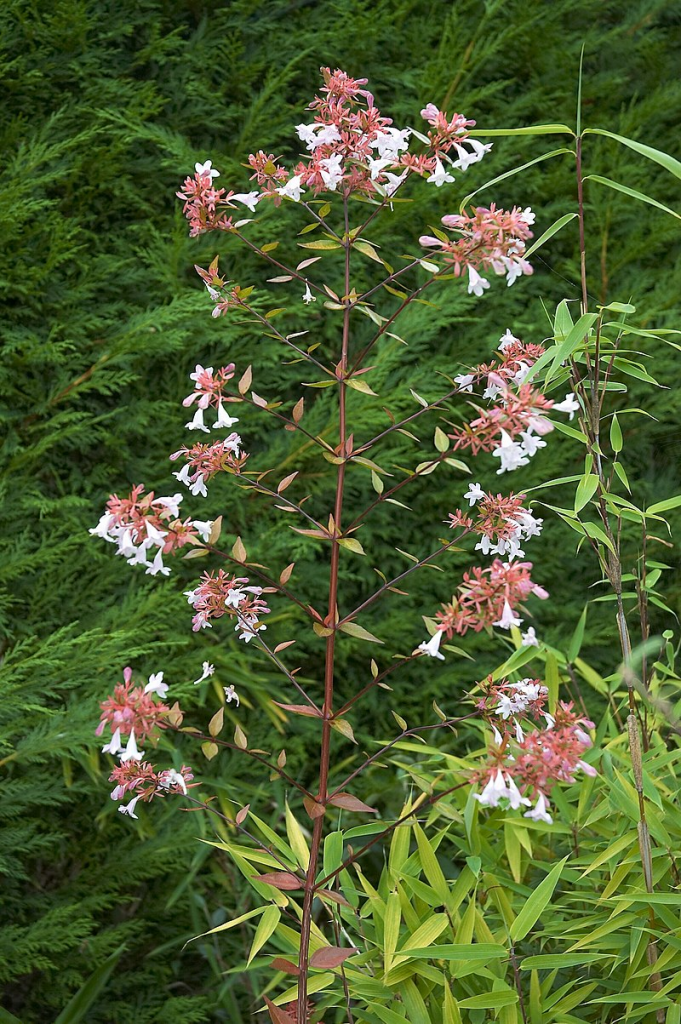
Abelia is a genus of about 30 species of deciduous and evergreen shrubs native to eastern Asia and Mexico. It belongs to the honeysuckle family, Caprifoliaceae, that also includes weigela, pincushion flower and teasel. Several species and hybrids are grown for their attractive foliage and long bloom time. The plants have an upright arching habit and grow 2-10′ tall and 2-8′ wide at a moderate rate. In warm climates they are evergreen while in cold climates they are deciduous. The leaves are up to 2″ long, oval with pointed tips, and may be glossy green or yellow with hints of burgundy, rose, bronze or variegated. Deciduous varieties may turn purplish-bronze to red in autumn. The flowers appear from late spring to early fall and are small, tubular, and have 4 or 5 white, pink or yellow petals. The petals are surrounded by a pink calyx that may persist after the petals fade ,and extend the bloom season. The flowers are fragrant and attract butterflies, hummingbirds and other pollinators.
Abelias are easily grown in fertile, consistently moist, well-drained soil, in full sun. They tolerate shade but produce the most blooms and best foliage color in full sun. Abelias are generally healthy but may suffer from damage by aphids, anthracnose, and powdery mildew. They have a pleasant form but may be lightly pruned to promote bloom and bushiness and to maintain size. Up to a 3rd of the branches may be removed to reinvigorate a declining plant. Slow release fertilizer may be applied in spring to promote growth when needed, and mulch may be applied to maintain consistent moisture and suppress weeds. Propagation is by seed (except hybrids), and cuttings. Depending on the species, Abelias are hardy in USDA hardiness zones 4-11.
Evergreen abelias are especially valued for winter gardens, screens, hedges, and foundation plantings while all abelias are valued in borders, specimen plants, and fragrance, butterfly, bird, and pollinator gardens. The compact dwarf forms do well in containers.
The genus name, Abelia, honors Dr. Clarke Abel (17801826), English naturalist and physician who was part of a British delegation to the emperor of China in 1816.
Photo Credit: Wouter Habens, Wikimedia Commons
Chinese Abelia (Abelia chinensis aka Linnaea chinensis)

Native to the lower elevations in the mountains of southwest China, A. chinensis grows 5-8′ tall, and is erect or mounded, although may appear weeping at the peak of the bloom time when the flowers weigh down the branch tips. The new growth of the densely branched shrub is covered with soft reddish hairs but becomes silvery-gray to grayish-brown with maturity. The 1/2″ long tubular flowers are fragrant and have white petals and green sepals that turn pink with maturity. Photo Credit Kurt Stuber Wikimedia Commons
Size: 5-8′ H x 3-6′ W
Bloom Color: White petals with pink sepals
Bloom Time: late spring to fall
Hardiness: Zones 7-9
Glossy Abelia (Abelia x grandiflora aka Linnaea × grandiflora)

This hybrid is the result of a cross between A. chinensis and A. uniflora and grows up to 10′ tall in the warm climates, much smaller in the colder part of their range. It has have arching branches that are reddish and hairy when young but develop exfoliating bark that reveal light inner bark when mature. The leaves are glossy and dark green before turning purplish-bronze in the fall. The fragrant, trumpet-shaped, flowers appear in terminal and axillary clusters and are 1/2″ long, white to pale pink, and surrounded by pink to purple sepals that persist into winter. Many cultivars are available that differ most significantly in plant size, and flower and leaf color.
Size: 2-10′ H-x 3-13′ W
Bloom Color: Pale pink
Bloom Time: summer to fall
Hardiness: Zones 6-9
Fragrant Abelia (Abelia mosanensis aka Zabelia tyaihyonii)

Also known as Korean abelia in honor of its place of origin, this deciduous shrub grows 4-6′ tall and has arching stems with ovate leaves that are bright glossy green before turning orange to burgundy in the fall. Pink buds open to white trumpet-shaped flowers in the spring and continue to bloom into early summer. They are exceptionally fragrant. Photo Credit: Michael Wolf, Wikimedia Commons
Size: 4-6′ H x 4-6′ W
Bloom color: Pink buds open to white flowers
Bloom time: Spring to early summer
Hardiness: Zones 4-8; does poorly in heat and humidity of zones 7-9
Abelia schumanni (aka Linnaea parvifolia)

Native to the deep valleys of mountain forests in China, this abelia grows up to 7′ tall and has green leaves that emerge bronze. The leaves are up to 1″ long, hairy, and often grey-green beneath. Funnel-shaped flowers appear singly or in clusters and are held horizontally or drooping. The flowers are fragrant, white to purple-lilac with orange specks on their bearded throats. Photo Credit: peganum Wikimedia Commons
Size: 7′ H x 10′ W
Bloom Color: White to purple-lilac with orange specks on bearded throats
Bloom Time: Summer to fall
Hardiness: Zones 7-10
Indian Abelia (Abelia triflora aka Zabelia triflora aka Linnaea triflora)

Also called Himalayan abelia this native of calcareous soils in dry scrub, rocky slopes, and grasslands of eastern Asia and N.W. Himalaya, has dull green leaves and terminal clusters of trumpet-shaped flowers with 5 white to pinkish petals and a very desirable vanilla fragrance. Photo Credit A. Barra
Size: 6-12′ H x 9′ W
Bloom Color: White to pink
Bloom Time: Summer to fall
Hardiness: Zones 6-9